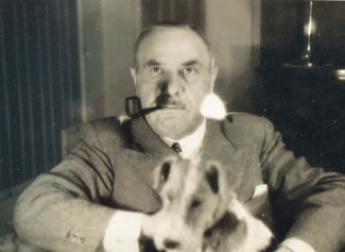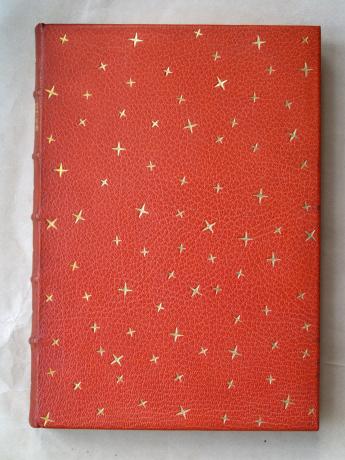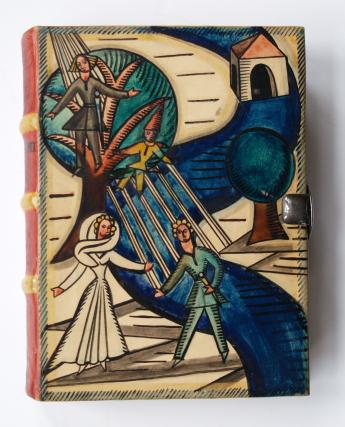Verband der Antiquare Österreichs
23 Wiener Werkstätte Bindings for Max Morgenstern â On Show in Vienna, until October 2015

In January 2015 Norbert Donhofer presented an extraordinary gathering of bibliophile treasures documented in a richly illustrated catalogue. The second part of this amazing collection will now be on display at the Grillparzerhaus in Vienna from 24 September to 9 October 2015. Max Morgenstern was one of the best customers of the Wiener Werkstätte. The Jewish collector belonged to a generation of Viennese bibliophiles who founded libraries with great knowledge, ultimate taste and a life-long passion. The precious bindings of the Morgenstern Collection, now on show at the Grillparzerhaus in Vienna, are a shining example of the outstanding artworks created during the Viennese Belle Epoque.
***
Maximilian (Max) Morgenstern was born 1883 in Mährisch-Weißkirchen. His father owned a textile mill in Bielsko (Poland). When Max inherited the company, it was somewhat run-down, because his father had spent most of the money with gambling. Through skill and hard work Max Morgenstern managed to rebuilt the company and made it a world-renowned and prize-winning manufacturer of high-quality cloth.
After serving in the Austrian army during World War I, Max Morgenstern met his later wife Hertha Israel. They married in 1922, two sons were born. The family settled in a large apartment in Wattmanngasse in Vienna’s 13th District. The Austrian capital, however, was too far from Bielsko, so Max Morgenstern worked in Bielsko during the week, the two sons were educated in England, while his wife took care of the family and the social life in Vienna. By the mid-1920s, Max and Hertha Morgenstern belonged to the upper class in Vienna. The couple welcomed famous guests – artists, authors, scholars – in their house which was furnished in the style of the Wiener Werkstätte.
“One can only imagine the glittering evenings with sumptuous food produced by Hertha’s cook for Vienna’s intelligentsia and artists gathered amidst Wiener Werkstätte furniture. As the guests sipped wine from elegant glasses designed by Josef Hoffman, Hertha presided over proceedings in a Wiener Werkstätte couture gown. The room would have been like a small art gallery with the work of different artists hanging from the walls, anything from August von Pettenkofen’s depictions of Hungarian gypsy and peasant life, to Johann Larwin’s lushly ripe paintings of flowers and fruit, to an Egon Schiele painting of an iris, to the dark, disturbing fantasies of Alfred Kubin and many others.” (John Morton)
The year 1938 brought dramatic changes for Max and Hertha Morgenstern, as for many other families in Austria. The Morgernsterns were lucky, many good friends in England and enough money enabled them to emigrate to England. In August 1938 Hertha Morgenstern left Vienna, after she had managed the export of the artworks owned by the family. Max Morgenstern had to take care of the company in Bielsko which was handed over to an employee, before he could follow his wife in September 1938. Both, the house in Vienna and the textile mill in Bielsko, were later looted by the Nazis. With the beginning of World War II the two sons were captured on the Isle of Man because they were suspected of espionage. Later, when the suspicion turned out to be false, the Morgenstern sons were deported to Australia. It was Hertha Morgenstern’s great courage and great anger that brought her sons finally back to England.
Very early, when he was 20 years old, Max Morgenstern started collecting, and there were two great passions that led him. He built up an outstanding library of press books, printed in limited editions, on large paper, in extraordinary bindings. His “Little Black Book”, the handwritten inventory of his library, contains around 1200 books, some of them exceedingly rare today. Among the private presses Max Morgenstern most admired was the Doves Press (London, 1901-1909). From 1908 onwards other private presses followed the example of the Doves and produced an amazing series of editions – milestones in book art. Max Morgenstern owned all Doves publications and most books printed by the other private presses of the early 20th century.
The second great passion of Max Morgenstern was the early work of Alfred Kubin, with whom he formed a lifelong friendship. Together with the German collector Heinrich Stinnes, Max was one of Kubin’s most important and influential mentors. Two third of all works shown in the great Kubin exhibition in Vienna in 1937 came from the collections of Morgenstern and Stinnes.
For Max Morgenstern, content and binding of a book had to form a harmonious unit – a dictum which even the most skillful book artists and famous private presses could not always fulfil. When, in his view, content and binding did not perfectly fit together, he ordered a new binding from the artists of the Wiener Werkstätte. 23 of these bindings from the Morgenstern Collection will be on show at the recent exhibition at the Grillparzerhaus in Vienna. They are rare, unique, and an artistic manifestation of the amazing creativity and outstanding skills of artists like Josef Hoffmann, Gretl Hamerschlag, Reni Schaschl, and Mathilde Flögl. The Archive of the Wiener Werkstätte at the MAK, Vienna, holds half of the original drafts of these bindings, of which the most beautiful and important will be presented in the exhibition from 24 September to 9 October 2015.
23 Wiener Werkstätte Bindings for Max Morgenstern
Exhibition at the Grillparzerhaus (Johannesgasse 6) in Vienna, 24 September to 9 October 2015
Official opening: Thursday 24 September, 6.30 pm. Norbert Donhofer will speak about the collector Max Morgenstern, Dr. Tobias G. Natter will speak about the Wiener Werkstätte bindings for Max Morgenstern
Opening hours: Tuesday to Sunday, 10 am to 6 pm (to 8 pm on Thursdays)
For more information visit the website of the Grillparzerhaus, Vienna, and Norbert Donhofer Rare Books


